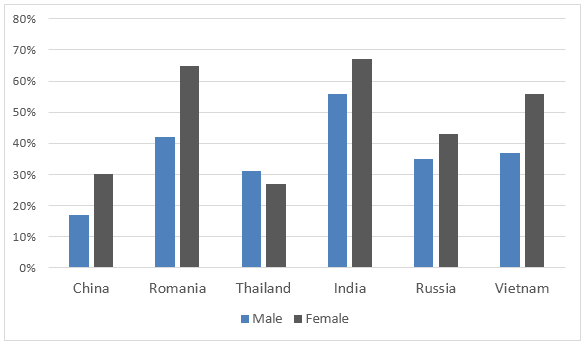IELTS graph 298 - Students who are proficient in a foreign language
- Details
- Last Updated: Saturday, 02 December 2017 20:15
- Written by IELTS Mentor
- Hits: 54532
IELTS Academic Writing Task 1/ Graph Writing - Bar Chart /Column Graph:
You should spend about 20 minutes on this task.
The bar charts below provide information about percentages of students who are proficient in a foreign language in different countries.
Summarise the information by selecting and reporting the main features, and make comparisons where relevant.
You should write at least 150 words.

Sample Answer:
The bar chart presents the ratio of male and female pupils in six countries who have good commands in a foreign language. It is obvious that more percentages of female learners are proficient in a second language than that of male pupils and the proportion of such fluent students is higher in India and Romania.
As the diagram summarise, the quotient of students versed in a foreign language was the highest in India, approximately 68% female students and 56% male students with the ability to use a second language. Romania has approximately 65% women pupils and just over 40% male students who are expert in a different language. Interestingly, the rate of students with skill in a foreign language is higher among females than that of males in all countries except in Thailand where such male pupils’ ratio is 30%. Vietnam has more ratio of second-language-knowing students than that of China, and Russia. The lowest percentages of such pupils reside in China where only around 20-30% disciples know a second dialect.

Overall, it is observed that female students have a higher figure when it comes to knowing a second language than their male counterparts. More specific information will be summarized below.
To begin with, one of the most noticeable features of the diagram is that Thailand is the only country that has a percentage of male students at about just above 30%, higher than that of female students (27%) who know a second language. Regarding China, this country has the lowest proportion of second-language-knowing students, as the figure for male students is 30% and for female pupils roughly half of this number.
Interestingly, approximately 35% of Vietnamese and Russian male students know a foreign language. And finally, male and female students from India and Romania have significantly higher ratios than the other 4 countries mentioned in the diagram, ranging from 40 to approximately 68 per cent. Around 68% of female students in India can speak a foreign language and this figure in Romania was around 65%.
Report